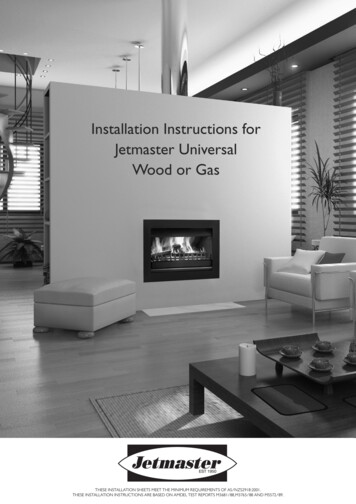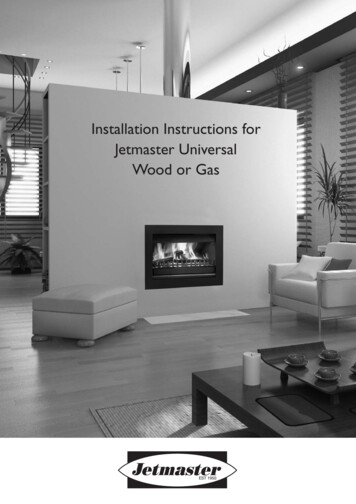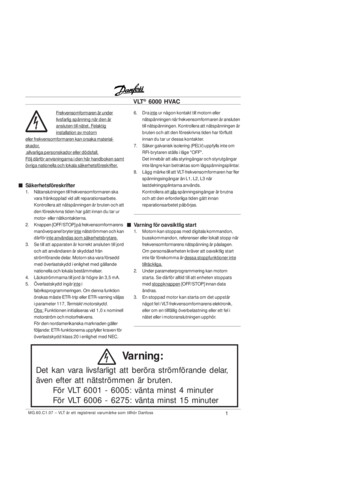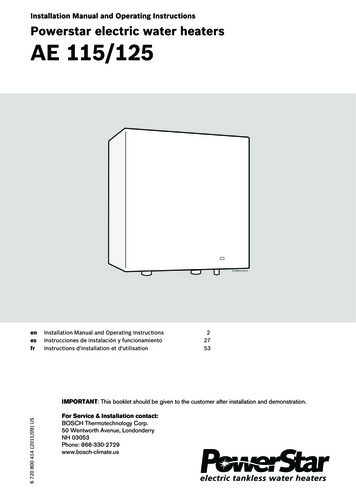
Transcription
Installation Instructions forJetmaster UniversalWood or GasTHESE INSTALLATION SHEETS MEET THE MINIMUM REQUIREMENTS OF AS/NZS2918:2001.THESE INSTALLATION INSTRUCTIONS ARE BASED ON AMDEL TEST REPORTS M3681/88,M3765/88 AND M5572/89.
IndexPage 2General Instructions - Timber frame installation Jetmaster Universal wood or gasPage 3Componentry and specificationsPage 4Frame out for Timber frame installationPage 5Timber frame installationPage 6Installation glossary timber frame installationPage 7Summary of minimum installation specificationsPage 8Installation diagram full brick chimneyPage 9Installation full brick chimneyPage 10Flue heights and terminationsPage 11Installation into existing fireplacePage 12TroubleshootingPage 13Fixing trims, fascias and mantelpiecesPage 14Using your wood fireplace
General Instructions Jetmaster Timber Frame Installation - Wood Or GasStep by step check listWarning! Please read these instructions carefully. Failure toadequately follow the instructions can result in serious injuryor death.1. Position firebox on a non-combustible hearth - seediagram No 1 Hearth - Summary of minimum installationspecs page 7.2. Bolt gather to firebox.3. Insulate entire firebox and gather where painted red withthe insulation provided.4. If using a lintel bolt lintel to firebox –insulate betweenlintel and firebox .You can lay your Hebel or brickworkdirectly onto the top of the firebox between the gatherand front flange of the firebox. However it is important toinsulate between the Hebel/brickwork and firebox. Activeflue must be sealed to brick or Hebel casing to ensureproper insulation of firebox. Outer flue ventilation abovesealed brick of Hebel casing.5. Ensure air intake area at bottom of unit is not obstructed.6. Brick or Hebel around firebox to a height 600mm abovethe firebox. Min 75mm Hebel block can be used.7. Do not recess the firebox by more than 110mm. Agreater dimension could result in convected heat loss.8. Use the double flue kit provided. Rivet an inner activestarter flue with two female ends to gather to allowsecond length to have crimp facing down. The outer flueis then installed outside active flue with crimp facing upto ensure water penetration on flue above roof runs out.Rivet active flues together at crimped joins.Fix outer non-active flues to active inner flues use 3 x25mm self-tapping screws through outer flue at bottomat each join and on top at each join.As an alternative, rivet 4 x 25mm conduit saddles at eachjoin top and bottom.Ventilate the flues, cut 4 x 25mm notches at bottom offirst length of outer flue and top of outer flue in eitherthe ceiling cavity or just below the ceiling. When using acover cone drill a series of holes into the outer flue belowthe Cover cone, to ensure adequate ventilation. It’simportant to ensure airflow between the outer and activeflues.Flue clearances: A minimum of 50mm clearance must bemaintained between outer flue and combustibles.9. A minimum of 3.6m of flue is to be used.10. Fit a recommended Jetmaster flue cowl to the top of flue.11. Gas burning. A ½ inch BSP inlet on right hand side isrequired. Drill at 100mm from base and rear of fireboxfrom outside of firebox. Avoid penetrating the fireboxfrom the rear.PAGE 2
Componentry And SpecificationsFlueRotatingcowlFixedcowlGas cap20mmGATHER AND FIREBOX DIAGRAMS (DIMENSIONS IN MILLIMETERS)MODEL400440500600600 Low700S700SH Low700D850850 Low1050 Low Low10501200*1500*PAGE 300350* REQUIRES 2x FLUE OUTLETS, SINGLE FLUE ALSO AVAILABLE IN LARGER 0I145140120120120120120150150150180180180180
Frame Out For Timber Frame InstallationNB Frame out allows for 100mm of Hebel onsides and back of firebox with a 25mmclearance from the firebox and 600mm ofHebel above the firebox.NB It is preferable to install the Unit and fluesprior to Timber construction,so mistakes areminimized.All fronttimber studsto beinstalledon edgeElectricalsif requiredGasconnection(DIMENSIONS IN MILLIMETERS)MODELA400640440720500820600920600 Low920700SH1020700SH Low1020700D10208501170850 Low1170105013901050 Low 75525575575625625725725PAGE 4
Diagram for Timber Frame Installation - Wood or Gas11,000 mm min2Flueclearances3mm min50 mDouble skin6Triple skin10 mmm min458117Ventilated outerflue above sealedbrick or hebel casing9Hebel 600 mm aboveheight of fireboxActive flue sealedwith non combustiblematerial betweenbrick or hebel casing10192021131812200 mm min15300 mm min100 mm min for models 850 - 150026 mm min for models 400 - 700D1816PAGE 517
Installation Jetmaster Universal Timber Frame Installation - Wood Or Gas1. Flue Termination. Choose from Rotating cowl. Fixed, DualFuel or Chinaman’s Hat.NB If using Chinaman’s Hat allow 120mm clearance fromtop of flue to hat.For gas installation use an approved AGA GAS COWL.2. Approved flashing.3. Rafters.4. Inner Active flue.5. Outer Flue.11. Make 4 ventilation holes in the outer flue and if a 2ndouter is used repeat. Holes should be 25mm by 50mmeach. Do not perforate the active inner flue.12. A 25mm air gap between Hebel/brickwork and thecombustible wall must be kept to allow air to flow behindbrickwork/Hebel and also into the outer flues.Enclosed cavities are not allowed if the combustible wallis removed and the unit is installed against or through thebrick wall, ventilation holes can be left in the hearthbetween the brick walls and the unit. It is important forair to flow between the flues.6. If the clearance of the outer flue (5) is less than 50mm tocombustibles a second outer flue must be used and itsclearance must not be less than 10mm to combustibles.Keep the same clearances for bends.13. Insulation to wrap around the firebox where painted red.7. Plasterboard: A 75mm clearance must be kept to theouter flange of the Firebox. If a flush finish or behind theflange finish is required then Villa board or the equivalentshould be used.16. 12mm AC Sheet.8. Combustible wall18. Reinforced concrete footing-Generally not required witha Hebel installation.9. There must be a minimum of 100mm Hebel around thefirebox and it must be taken to at least 600mm above thetop of the firebox. NB if using bricks then 115mm isrequired around and 600mm above firebox. Active fluemust be sealed to brick or Hebel casing to ensure properinsulation of firebox. Outer flue ventilated above sealedbrick or Hebel casing.10. Timber stud.14. Air intake – Do not obstruct.15. Hearth (See diagram 1 Page 7 – Summary of minimuminstallation specs).17. Timber floor.19. Insulate between top of firebox and Hebel/brick with theinsulation provided.20. If rendering keep a 2mm expansion gap to flange.21. For burning gas a ½ inch BSP inlet on RHS of firebox isrequired. Drill at 100mm from base and rear of firebox.Avoid penetrating the convection chamber located at therear of the firebox.PAGE 6
Summary Of Minimum Jetmaster Installation Specifications1. HearthAutoclaved aerated lightweight concrete block,or for hearths26mm thick FC Sheeting or any suitable non combustiblematerial like slate, granite or marble is acceptable. Models 400-700D must be minimum 26mm thick. Models 850-1500 must be minimum 100mm thick.This includes selected finish such as ceramic tiles, marbleor granite. Must project forward of aperture by a minimumof 300mm. Must project either side of aperture by a minimumof 200mm.300mm MINJETMASTERSELECTED FINISH100mm MIN (Models 850-1500)26mm MIN (Models 400-700D)BRICK ON EDGEBRICK ON FLATJETMASTER300mm MIN.200mm MIN.2. Flue Single skin flue (stainless steel) must be enclosed withsingle skin brickwork, concrete, or autoclaved aeratedconcrete block. Twin skin flues (stainless steel inner, and galvanised outer)can either be left exposed or enclosed with stud walls andsheet plaster or timber. A minimum of 50mm clearancemust be maintained between the outer flue and anycombustibles. If using double skin flues space inner andouter flues using 3x25mm self tapping screws throughouter casing at bottom, at each join and at top.Also ensurethat flues are ventilated at top and bottom, and when usinga cover cone drill a series of holes into the outer fluebelow the cover cone to ensure adequate ventilation. PAGE 750mm MIN.CLEARANCETWIN SKIN FLUESTAINLESS INNERGALVANISED OUTERFit cowl to flue or chimney breast.3. Enclosure SINGLE SKINSTAINLESS FLUEA minimum of single skin brickwork, concrete, orautoclaved aerated concrete block must surround thefirebox and gather at back, sides and front. A minimum of25mm air gap filled with insulation material provided mustbe maintained.25mm MIN.INSULATIONBRICKWORK
Installation Instructions Full Brick ChimneyALTERNATIVEBRICK CHIMNEYTERMINATION3URYLGH RXWHU VOHHYHWR DOORZ IRU H[SDQVLRQDQG FRQWUDFWLRQ RI DFWLYHIOXH DQG YHQWLODWLRQ RI 10,000mm2 WR FKLPQH\FDYLW\6SOD\HG UHQGHUWR GLVSHUVH UDLQZDWHUDZD\ IURP WRS RI IOXH1214Fibre cement¶FROODU·DURXQG IOXH10101110 [ PPFKLPQH\ RSHQLQJV PLQ VL]H127( ,I FKLPQH\ LV PRUHWKDQ PP ZLGHWKHQ WZR RXWOHWV RQO\ DUHTXLWH SUDFWLFDO RQ WKH ORQJVLGH RI FKLPQH\ ZLGWK RIRXWOHW WR EH ZLGHQHG LQDFFRUGDQFH ZLWK WKH OHQJWKRI WKH FKLPQH\ [ PPFKLPQH\ RSHQLQJVPLQ VL]H,VRPHWULF YLHZ,QVXODWH ILUHER[FRPSOHWHO\ WREULFN WR HQVXUHQR KHDW ORVV13%ULFN FDSSLQJ PP RYHUKDQJ3URYLGH RXWHU VOHHYHWR DOORZ IRU H[SDQVLRQDQG FRQWUDFWLRQ RIDFWLYH IOXH 56 8)LEUH FHPHQW VKHHWVRI VXIILFLHQW WKLFNQHVVWR VXSSRUW EULFN FDSSLQJDQG VSOD\HG UHQGHU DQGWR SURYLGH D FROODU WRUHVWUDLQ WRS RI IOXH6WDLQOHVV VWHHOIOXH415322116HFWLRQPAGE 8
Installation With Full Brick ChimneyStep by step check listWarning! Please read these instructions carefully. Failure toadequately follow the instructions can result in serious injuryor death.Installation with full brickchimney1. Re-inforced concrete foundation.Suspended floors will require supports and footings.1. Position firebox on a non-combustible hearth-see diagram1 page 7 (summary of minimum installation specs.)2. Hearth.2. Bolt gather to firebox.3. Air inlet. DO NOT BLOCK.3. Insulate entire firebox and gather where painted red withthe insulation provided.4. Firebox.4. If using a Jetmaster lintel, bolt lintel to firebox. If using anangle bar as a lintel you can use the side Hebel orbrickwork to support the lintel - insulate between linteland firebox.You can lay your Hebel or brickwork directlyonto the top of the firebox between the gather and frontflange of the firebox. However it is important to insulatebetween the brickwork and firebox. Also insulate betweenflue and brickwork.6. Optional lintel, as firebox supports brick wall. (If otherthan the Jetmaster lintel used, a 100 x 10 angle bar isneeded and allow at least 2mm for expansion.5. Ensure air intake area at bottom of unit is not obstructed6. Brick around firebox.7. Do not recess the firebox by more than 110mm.A greaterdimension could result in compromise in convected heat.8. Rivet an inner active starter flue to gather with two femaleends to allow second length to have crimp facing down.Rivet active flues together at crimped joins.Encase the flue with brickwork and it is suggested that apiece of 9mm fibre cement sheeting with a circular cutout to accommodate the flue be positioned on thechimney opening, one course of brickwork from the topof the chimney. Slope mortar outward from the flue whichshould protrude through the cement sheet by 50mm(see diagram page 7 alternative brick chimney termination.9. Fit a recommended Jetmaster flue cowl to the topof chimney.10. Gas burning - A ½ inch BSP inlet on right hand side isrequired. Drill at 100mm from base and rear of fireboxfrom outside of firebox. Avoid penetrating the fireboxfrom the rear.PAGE 95. Gather.7. Insulation.8. 115 minimum brickwork.9. Gap between stainless steel flue and brickwork may(optional) be filled with mortar (8 sand, 3 lime, 1 cement).10. Approved Flashing.11. Drip tray.12. Jetmaster stationary cowl, rotating cowl, (also see diagramalternative brick termination-this page) A.G.A. gasapproved cowl when using gas.13. Optional 45 degree bends or offset gather available.14. Fibre cement sheet under last course of bricks with holecut to restrain flue. Provide outer sleeve to allow forexpansion and contraction of active flue and 10,000mm2ventilation to chimney cavity when filling space below cowlbase with mortar.15. For burning gas: 1/2-inch B.S.P. inlet on right hand side offirebox is recommended. Drill at 100mm from base andrear of the firebox measuring on outside of firebox.Important points Do not block air inlet. Cover all surfaces of fireplace,including, gather, with insulation provided. Build the brickwork at the back and sides of the fireplaceagainst insulation. Seal any gaps between gather andfirebox with the fire cement or insulation provided.
Flue Heights & Flue Termination3.6 metres or greaterRidge Line1 metreminimumLess than 3.6 metresRidge LineExtend flue 400mmabove ridge line50mmclearancebetween roofingmaterials&any othercombustiblematerials1 metre minFlue CowlAGA approvedto AG604500mmminGas BurningFlue TerminationPAGE 10
Installation Into An Existing FireplacePlease read these instructions before beginningStep by step checklist1. Check the chimney for cracks, cavities and blockages andrepair these.The size of the Jetmaster Firebox is determinedby the minimum dimensions of the chimney flue.Minimum flues areas are:Model 500, 600, 700sh- 400 cm2Model 700D, 850-450 cm2Ensure that this area is maintained throughout the entirechimney.Flues that are 10% smaller than this will work dependingon the height of the chimney. Chimney pots that are toosmall should be removed. Stainless steel flues may be usedif the chimney is in poor condition.2. Measure the width, depth height of the recess. Thefollowing table lists the minimum dimensions of the recessfor each unit.UNIT SIZE WIDTH500570600670600 Low670700SH770700 Low770700D770850920850 Low920105011001050 Low1100 640590690740690790690Allow 25mm on each side of the firebox for insulationA. Recess too large:1) The recess can be reduced by inserting bricks orHebel at the sides and/or back, and where necessarybetween the top of the unit and the underside of thelintel. The existing hearth can also be built up eitherwith bricks or by forming a plinth.II) Use Jetmaster fascias and trims to seals gaps less than75mm between sides and top of the unit and masonry.B. Recess too small: The recess can be made deeper byremoving the rollback and smoke shelf. If the height is toolow, remove the lintel and replace at the required height.If the sides have to be removed it is suggested anexperienced builder to do the work as the sides supportinner flues of the chimney.NOTE Allow 1mm expansion gap for all materials.PAGE 113. Repair any cracks or cavities in the recess especially if ithas been chopped out to accommodate a specified unitsize, and the cavity between a double brick wall has beenexposed.N.B. No metal gather is required. The Jetmaster isdesigned to operate in existing fireplaces without usingthe gather or metal flues.4. Tape the insulation to back and sides of the Jetmaster andslide into position, taking care not to snag the fibreglassinsulation against the sides.The check:A. Do not recess the unit by more than 110mm.B. The two smoke outlets on the firebox marry up withthe existing chimney. (There must be a 200mmminimum to any overhang above smoke outlets).C. Do not obstruct air intake at the bottom of the unit.5. At this stage block the gaps between the unit and recesswith pieces of cardboard and have a test fire using paperonly. If continuous smoking occurs, check size of chimneypots again. Also check for blockages in the chimney.“Downdraught” (wind blowing down the chimney isrecognised by occasional puffs of smoke. In this case useJetmaster rotating cowl. If smoking persists a smallerJetmaster will have to be used.6. Seal unit into position with the masonry, fascias or trims,ensuring any air leak around frame is limited. Allowmasonry work to cure for a minimum of three days.See next page for diagrams.
Installation Into An Existing Fireplace1aIf masonry overhangsthe smokeholes theremust be at least a 200mmclearance above the unitGap from lintelto be bricked orfirebox raisedSmokeshelfInsulationRollbackExisting fireplacerecess and chimneyHearthIf recess is too small removeRollback and Smokeshelfas belowB. Fireplace recess too large(more than 75mm) - use bricksto build up and reduce sizeA. Fireplace recess slightly too large(less than 75mm) - pack with withextra fibreglass insulation1b23Fibreglass insulation(supplied)N.B. No metalgather requiredAllow 1mm expansion gapfor all materialsSealSmoke outletsNot recessed bymore than 110mmHearthFibreglass insulationAir intake must notbe obstructedGaps greater than 75mmto be bricked. If less than 75mmJetmaster fascias and trims canbe used to cover the gapInfill strips of marble/sone/tiles10mm overlap infront or behind frameJetmastermantelpieces have20mm or 100mmrebateFireplace surround(i.e. mantelpiece)Troubleshooting1. Check that the gather is sealed to the firebox.2. Check chimney. If chimney is closer than 3 meters to theapex of roof, the chimney should extend approximately350mm past the apex. Chimney should be a minimum of3.6 meters from the top of the gather.Recommended flue sizes.UNIT500/600/700S700 DEEP8501050FLUE SIZERound(diam. mm)200225250300FLUE SIZESquare(mm)225x225250x250250x250300x3003. The cross section area of flue should be within 100% ofthe recommended size through its lengths and preferablystraight. The angle of any bend should be more than 45%degrees. Chimney pots, which are too small to allow freeflow, and mortar droppings at flue bends, are frequentcauses of smoking.4. Check smoke outlet. With the damper fully open, checkfor mortar dropping over the smoke outlet. Such mortarcan be removed with a long cold chisel.5. Check ‘False’ drafts entering around side of firebox / fascia/ mantelpiece into cavity. Use fiberglass wool to preventair movement.6. Check air intake is not obstructed.7. Check damper properly located on pivot-pins.PAGE 12
Fixing Trims, Fascias and MantelpiecesTrims1. Score the back of the stainless steel or mild steel trim andthe surface to which the trim will be attached, to allowthe two surfaces to adhere well to each other.Attach trim to flange offirebox with heat resistantsilicon (roof and guttersilicon is recommended)2. Place a bead of Silicone onto the back of the stainless steeltrim.3. Place another bead of Liquid Nails around the outer edgeof the frame.This will cure quickly and hold the frame intoposition.4. Clamp the trim onto the unit for 24 hours until theadhesives have curedAttaching FasciasUse masonry plugs and drill through corners of fascia andattach to bricks or masonry.If attaching to plasterboard use suitable toggles If neither ofthe above is suitable, then use heat resistant bonding silicon.N.B. Mantelpiece will hold fascia in position.It may be necessary to leave fascia up to 10mm out of cavityto allow for flush fitting with mantelpiece. Use fibreglass woolto block gaps between fascia and cavity surrounds.Fitting ScreensClip on ScreensFor standard flange, square fascias and trims (Hang flush withopening. Locate lugs between flange and louvre).Attaching MantelpiecesIf fascia fits flush with wall no rebate on mantelpiece isnecessary.If fascia sits proud of wall, a rebate on mantelpiece isnecessary. Most Jetmaster mantelpieces come with a 20mmrebate.When mounting a mantel-piece, use mirror hooks or othersuitable fixing brackets.PAGE 13Cast iron fascias canbe bolted and fixed tothe plasterboard orbrickwork behindfirebox
Using Your Wood Fired Jetmaster UniversalHow to use the woodfireplaceYour Jetmaster fireplace is designed not to smoke and byfollowing a few instructions you will achieve optimum heatoutput, convenience and fuel economy.Please note that the first fire could result in a few odourscoming from the firebox. Do not be alarmed. This is notunusual when first using a metal finished product and willsoon cease.Lighting a fire1. Using a number of crumpled sheets of newspaper, somekindling and a few small split logs arrange your fire in a“Tepee tent” style.2. With the tool provided, fully open the DAMPER by pullingthe control lever towards you. (Not always applicable withDouble Sided Firebox.)3. Light the fire at both ends as well as at the centre.4. When the kindling and small split logs are burning well,start to build up your fire with larger split logs.5. When the fire is well established you can start closing theDamper. The amount you can close it will depend on thetype of wood used and the general weather conditions.General MaintenanceThe visible parts of your Jetmaster can be cleaned with adamp cloth or soft brush. Should you wish you could repaintthe unit with a heat resistant paint?SafetyThe Jetmaster is a safety-tested unit. However, you must neverleave an open fire unguarded. Jetmaster has a screen that isdesigned to prevent sparks leaving the fireplace and veryresistant to being accidentally knocked over by youngchildren.Fuels1. Medium density woods are preferred for open fireplaces.Softer woods (Pines etc) burn fast, leaving a lot of ash andcreosote. Hard woods (Red Gum etc) can be best usedwhen mixed with medium woods and should not be usedto start a fire.2. A split log will burn better than a full log.3. Wood should be stored (seasoned) in a dry ventilatedarea for at least 12 months.Experience will soon show you how far; however, thedamper should never be closed more than half way.“Green” wood can have 50% moisture, which results in avery poor heat emission. Box woods (e.g. Grey Box andYellow Box) are highly recommended as they produce finecoals.6. When the fire has gone out completely, you can close theDamper fully thus preventing any loss of heat from theroom up the chimney.Burning well seasoned medium density wood is the mostimportant step towards achieving optimum results fromyour Jetmaster!CleaningGas Fires1. The Jetmaster Log Pan is designed to give greater heatand fuel efficiency. For the duration of the cold season theLog Pan should never be emptied.The resulting bed of ashand coals from previous fires will soon become a heatbank generating more heat than the burning logs.This ashbed also insulates and greatly extends the life of the LogPan.This is why an ash bed must be maintained at all times.See separate installation manual with gas burner.When the level of the ash bed becomes too high, the toplayer can be removed.Depending on frequency of use and quality of wood, thisskimming procedure should not be required more thanonce or twice a Season!2. To prevent chimney fires as well as enabling the chimneyto draw properly, the chimney/flue should be swept atleast once a season, subject to the quality of timber usedin the fire.PAGE 14
NotesFor further information contact Jetmaster AustraliaT: 02 9597 7222 F: 02 9597 7622E: sales@jetmaster.com.au W: www.jetmaster.com.au
Min 75mm Hebel block can be used. 7. Do not recess the firebox by more than 110mm. A greater dimension could result in convected heat loss. 8. . prior to Timber construction,so mistakes are minimized. Diagram for Timber Frame Installation - Wood or Gas PAGE 5 2 mm min mm min 1 3 4 5 8 11 50 m 1,000 mm min 10 m 21 20 19 6 7 10 9 clearances










